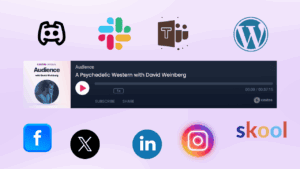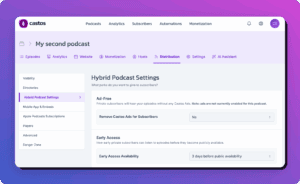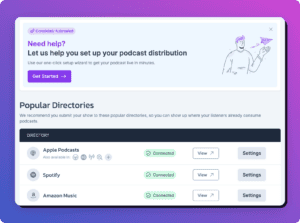Earlier this year at Apple’s WWDC annual conference, they announced some awesome new features coming for podcasters. In iOS 11, there will be some new tags and features that many of us have been begging for. Fortunately, Apple listened by creating new iOS tags to improve the listening and content creation experiences.
All of the iOS tags below are now included in v1.18 and higher of Seriously Simple Podcasting.
Easier Rating and Reviewing
If you’ve ever either rated or reviewed a podcast or encouraged your listeners to do the same, you know that the process is a giant pain in the neck. Thankfully with iOS 11, Apple has made this process a lot easier.
Previously, your iTunes URL would take visitors to different areas of the iTunes app depending if they already subscribed to your podcast. This confused listeners who were trying to leave a review and harder to podcasters to guide them through the process.
Fortunately in iOS 11, now rating and reviewing podcasts is easy whether you’re subscribed to the podcast or not. Now reviews and ratings are visible from a listener’s subscription library and the general category where your show is listed.
Here’s hoping that this change will reward those with great ratings and reviews by allowing for increased discoverability by new listeners.
Global Podcast Settings
These are settings that affect your podcast feed meta data as a whole. These are not per-episode tags. Settings for this are found in the Podcast -> Settings -> Feed Details area for your show or Series.
<itunes:type> – Episodic or Serial Shows
In a lot of ways the blockbuster podcast Serial from the team at Gimlet Productions changed the world of podcasting. It very much popularized the concept of listening to podcast episodes in a particular order, with each week building on the previous episode.
Prior to iOS 11 there was no real way to tell your listeners that your show was this type of “Serial” podcast. They could listen ‘out of order’, if you will, without knowing any better in a lot of cases. But now in iOS 11 you’re able to tell subscribers that a podcast is either Episodic or Serial. With the former the order in which listeners go through your episodes isn’t as important….the content doesn’t necessarily built on the previous episodes.
This is a Global type setting in your podcast feed, and will apply to your show as a whole, not something that you need to adjust on a per episode basis.
Episode Tags
These are per-episode settings you can make for each podcast episode. These tag settings are found in the Podcast Episode Details area in the WordPress post editor for each episode.
<itunes:description> Episode Description
Episodes descriptions have previously been able to accept some HTML styling but now with iOS 11 these are enhanced a bit, and a bit better defined.
Now you’re welcome to include a handful of HTML tags in your podcast RSS feed Episode Description area:
- <p> – Paragraph
- <ol> – ordered list
- <ul> – unordered list
- <a> – links
- <strong> – bold text
- <em> – italicized text
<itunes:season> Season number
If you publish your podcast in seasons then this is the place to tell iTunes and your listeners about it. Entering in your Season # here will order your episodes correctly in iTunes and give new listeners a good starting place for your season based ordering.
If you don’t publish your show in seasons then there’s nothing to do and this field will remain blank in your feed.
<itunes:episode> Episode number
Giving each episode a unique episode identifier is going to allow for some really cool things, especially when it comes to Siri and other AI interfaces. Imagine things like Amazon’s Alexa being able to play particular episodes of your favorite podcast, by episode number. This is a much more robust identifier than an Episode Title, so might be worth starting to include in your podcast episodes.
If you’ve already got a bunch of episodes it’s not absolutely required that you go back and update each episode individually, but might not be a bad idea either. Each of these new fields in your podcast RSS feed is designed to give finer grain control over the search ability and filtering of your podcast content, so the more details you can give iTunes and your audience the better.
<itunes:title> iTunes Title
Going alone with the <itunes:episode> number parameter in your podcast RSS feed is the Title of each episode. This is a one-liner that should be descriptive but also give a bit of intrigue and ‘draw’ to listeners.
For a lot of listeners the title of your episode will make the decision of whether they’ll listen to an episode, so give it some thought. We’ve found that a combination of descriptive and somewhat catchy episode titles work the best.
Together <itunes:title>, <itunes:episode>, and <itunes:season> will give a complete view of what each podcast, and each podcast episode is all about. Using each of these gives iTunes and your listeners the most information about each new episode of your show.
<itunes:episodeType> Episode Type
Although I’ve not used this format of podcast episode much this is probably the thing that I’m most excited about seeing in the wild. Episode Types are now formally introduced. The three episode types are:
- Full (most common) – this is a standard podcast episode, and is in full length.
- Trailer – if you’re publishing a promo piece of content that’s a teaser for an upcoming new season, new promotion, or an intro to an entirely new show you can use this to let listeners know that this is a shorter episode.
- Bonus – Giving your listeners a little something extra? Let them know that Christmas is coming early and a Bonus Episode is ready for them. Something like a behind the scenes or inside interview would be a great way to use this episode type.
For the most part you’ll be using the default Full episode type, but I’m excited to see how some of us use both Trailer and Bonus episode types to further engage our listeners and create a more dynamic show.
Siri Integrations
I touched on this a bit above with the more robust naming/numbering configuration that iTunes is creating with these iOS 11 podcast tags, but one thing that it really opens the door for is ‘Smart’ tools like Siri or Amazon’s Alexa to allow you to interact with podcast playing in a whole new way.
Voice activated podcast browsing, exploration, reviewing, etc. may all be just around the corner, and your podcast listeners‘ experience will be drastically improved if you start adopting some of these new feed features in your podcast.


